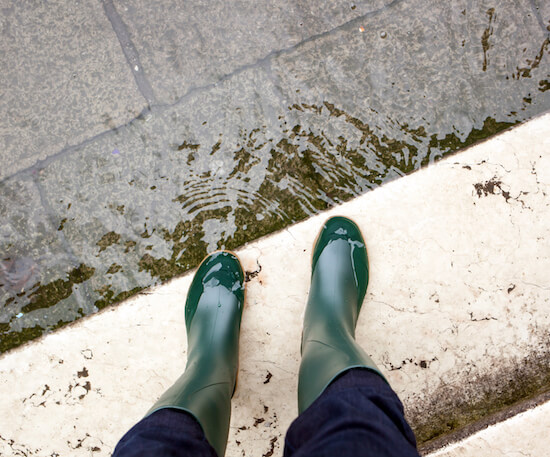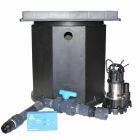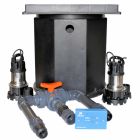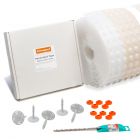Help & Advice Articles, Videos and How-to-Guides
Filter Articles

How to Protect Your Home From Flooding
Unfortunately, flooding is more and more common in the UK. This means that increasing numbers of people are experiencing the emotional and financial impact of flood damage to their homes and possessions. In this guide, we look at what you can do to protect your home from flooding and share advice on how to repair a flood-damaged property in the best way.
Ways to Prevent Flooding
You have several options when it comes to preventing flooding as well as steps you can take to limit the impact of a flood should it happen. Ideally, buildings at risk will have a flood strategy in place that contains two types of defence – flood resistance and flood resilience.
Resistance is all about stopping water getting into your property. A building’s flood resilience is about limiting how much damage is caused and ensuring it is easier to make good following flood water ingress. Flood repairability is something that should be considered when selecting any materials and furnishings in your home.
It’s important to find a balance between flood resilience and resistance that takes into account the risk, your specific situation, and your budget. When it comes to flood proofing your home, you may find some flood-resistant measures such as flood doors and barriers become prohibitively expensive.
VISIT OUR FLOOD PROTECTION CATEGORY
Flood Resistance Measures and Products
Flood resistance is about preventing or minimising flood water entering a property. Essentially, actions you can take to stop water from making its way inside your home. Some newer properties are built with flood-resistant design in mind. With older properties, you will need to look at installing products and systems retrospectively.
There are several flood resistant options out there, spanning external masonry protection to traditional sandbags to more innovative flood solutions. It’s important to gain an understanding of the weak points where water will most likely enter your home to understand the best solution. Here are some example products:
- Floodproof doors and windows
- Self-closing air bricks / air brick covers
- Flood boards
- Flood barriers / skirts
- Gel water-inflated flood bags
- Non-return valves
- Sandbags
Some of the above products are manually operated whereas others can function automatically using sensors.
Flood Proofing Your Home
Here are some key considerations around flood proofing your home and ensuring you’re adequately protected.
-
Install basement waterproofing
If you’re at risk of flooding and have a cellar or basement you should install a basement waterproofing system. You can read our complete guide to Type C cavity drain systems for the most reliable form of below-ground waterproofing or check out our guide to cellar tanking as an alternative method. -
Protect external masonry to prevent ingress
At Permagard, we stock a range of flood-resistant products focussing on external masonry protection and tanking. Together these prevent or minimise the amount of water entering your home and damaging its fabric during a flood. -
Install a non-return valve to your waste flow
A big problem when the area around your property floods is that drains back up. This means that water can flood your home through lavatories and washbasins. A non-return valve makes sure that water only flows through the valve in one direction, minimising the damage of wastewater backflow. -
Check for gaps in doors and windows
Any gaps around your doors or windows will always let water in, but it’s surprising quite how much water can ingress without barriers or other flood protection solutions in place. You can buy flood protection doors and window frames as well as flood skirts for the gaps around windows and doors. -
Invest in air brick covers
You can buy covers for airbricks to stop water travelling through them. They are relatively inexpensive and an important step in terms of flood prevention.

Flood Resilience Measures and Products
Flood resilience is all about limiting the damage caused when flooding occurs so that you can get back to normal as soon as possible. Resilience also covers flood repair, looking at how quickly, easily and cost-effective it is to clean, make good and replace damaged items in your home.
Some aspects of resilience are practical common sense steps including how you furnish and arrange your home. It also means choosing building materials both for water resistance and repairability which is where Permagard can help.
At Permagard, we focus our resilience range on materials that are water-resistant and therefore won’t be damaged by flood water. These include plasters that don’t need to be ripped out and replaced such as PermaSEAL Renovating Plaster and Limelite High impact finishing plaster. Our PermaSEAL PRO High Strength DPC and PermaSEAL Liquid DPM also prevent lasting damage from flood water.
Practical steps
The following are some actions you can take to limit damage in your home and reduce the impact in the event of a flood:
-
Use floor tiles in flood-prone areas
If you’re in a flood-prone area, consider using tiles and rugs rather than carpet throughout the house. You can easily mop tiles or slates if the worst happens and flooding does take place, whereas carpets are harder to clean and dry. It will also cut down on the costs of repairing your home after a flood. -
Move important documents to a safe place
One of the keys to preventing serious damage to your home and possessions when it floods is preparation. Move important documents, folders and precious items to safe ground. -
Know where weak spots are
When it comes to flooding, water tends to enter your property at weak spots. Gaps in the floor, airbricks, doors, windows and patios are all areas of weakness, as well as drains and pipes. This should help you spot early signs of ingress. -
Pack a flood kit in case of emergencies
An emergency flood kit can really make a difference if you need to leave your home in a hurry. It should only contain simple items like a change of clothes, a first aid kit, personal identification and insurance documents and any required medication. -
Move shelves higher
Move your shelving higher and put important items and things you might need on them. There’s nothing worse than finding you need something that’s inaccessible due to flooding. -
Remove electronics
Make sure there is no electricity flowing through the house – remove home entertainment systems, appliances and lights. Flooding and electricity are a lethal combination.
Prevent Your Basement From Flooding
Homeowners can reduce the risk of flooding by installing a Cavity Drainage system with a sump and pump in their basement. A sump and pump system removes ground water from basements, cellars and light wells, providing homeowners with peace of mind against flood risks and other severe weather conditions.
Our PermaSEAL Basement Sump and Dual Pump System has a HDPE sump chamber, two submersible pumps and the option for a high-level water alarm. The dual pumps reduce the risk of flooding more than a single pump system, because the secondary pump is in place, continuing to pump if the first pump fails to operate.
When installed, the high level water alarm alerts you if the water rises above the normal operating level within the sump chamber. This system will still work even during a power cut with a battery back-up system, which ensures the pumps are supplied with power.
Read more on how Sump and Pump systems work or stopping basements from flooding.
Permagard is always happy to provide installation advice. Sump and pump systems should always be installed by a trained electrician or a professional waterproofing company.
What to Do If Your House Floods
When your home starts to flood, you should do the following:
-
Turn the electricity off
The last thing you want to do is to have electricity in the area where water is lying. The water could be charged and lethal if stepped in - always wait until a professional is on the scene. -
Move yourself and treasured possessions to higher ground
If you can, move yourself, family and any treasured possessions to higher ground or a safe location as soon as possible. Often in these scenarios, the community come together so don’t be afraid to seek help. -
Don’t pump out water if water levels are still high
It’s important not to pump water out of the house if external water levels are still high. Doing so will only lead to more problems, putting a huge amount of unnecessary stress on the outside walls of the house. If possible, it’s best to wait until the water has subsided a bit before pumping it away. -
Take care and use the right equipment & safety gear
The process of flood repair will be a lot easier if you take precautions and take your time. Having the right equipment and wearing the right waterproof clothing will make the daunting task more manageable. Flood waters may hide sharp objects, obstructions and occasionally chemical waste or sewage. Again, it is worth getting professional help. -
Contact flood repair experts after the water has subsided
After you have contacted your insurer, taken a record of what has happened and cleaned up to the best of your ability, you will need to contact construction experts who specialise in flood damage repair. Permagard offer flood resilience and repair products to suit a range of budgets, including bags of renovation plaster and PermaSEAL liquid DPM.
Repairing Flood Damage
Once the flood waters have subsided, you need to tackle the flood damage and start to make good your home. This is an ideal time to build back with future resilience and repairability in mind. You should take the opportunity to choose water-resistant building materials that don’t need to be ripped out. It’s also a chance to take simple steps to prevent mould growth as things dry out.
Sanitise
If your property has suffered from flood damage, a disinfectant and sanitiser is the first product you should use before you do any other repair work. A concentrated sanitiser protects against bacteria including hepatitis B, salmonella, campylobacter, listeria, MRSA and many others. The sanitiser must be used before any cleaning and remedial work. Select a product with a highly potent biocide system so you can be confident in eliminating bacteria and a wide range of viral infections.
Isolate
Protect new surface finishes by isolating damp masonry walls. This can be achieved by hacking off the flood-affected plaster and render, taking it back to the original masonry (normally brick).
Once you have removed this contaminated material, you can install one of two types of isolating systems:
PermaSEAL 3 Meshed Damp Proof Membrane – a 3mm mesh plastic membrane designed to isolate the damp background and provide an excellent key for lime mortars, renders, plasters and dabbed plasterboard. It acts as a barrier for your new finish against water, alkalis, saline solutions and organic acids and is resistant to bacteria, fungi and many other organisms. By using a renovating plaster, you avoid the need to replaster in the future.
PermaSEAL Tanking – a completely waterproof coating that can be applied to the substrate to create a waterproof barrier. Once installed, it should then be rendered with PermaSEAL Renovating Plaster, a special render that contains waterproofing and salt-inhibiting additives. These additives stop salts or damp travelling from the background through into the final skim finish.
PermaSEAL Fleece Overstrip – a one-sided fleece overstrip tape, used to seal or repair mesh membranes. Its geotextile texture enables you to render directly over it.
PermaSEAL Damp Proof Paint – acts as another type of damp proofing membrane. PermaSEAL Damp Proof Paint is supplied ready to use. It is easily applied to masonry surfaces by brush, roller or spray to create a waterproof barrier.
Permagard - Helping you protect your home from flooding
If you need any more information on how to prevent flooding in your home, contact the experts at Permagard for free technical advice for your project on 0117 982 3282 or email [email protected]. You can also browse our flood protection and basement waterproofing categories where you can find products to help you prepare for flooding alongside our resilience and repairability flood range to make it easier to repair damage if the worst does happen.



